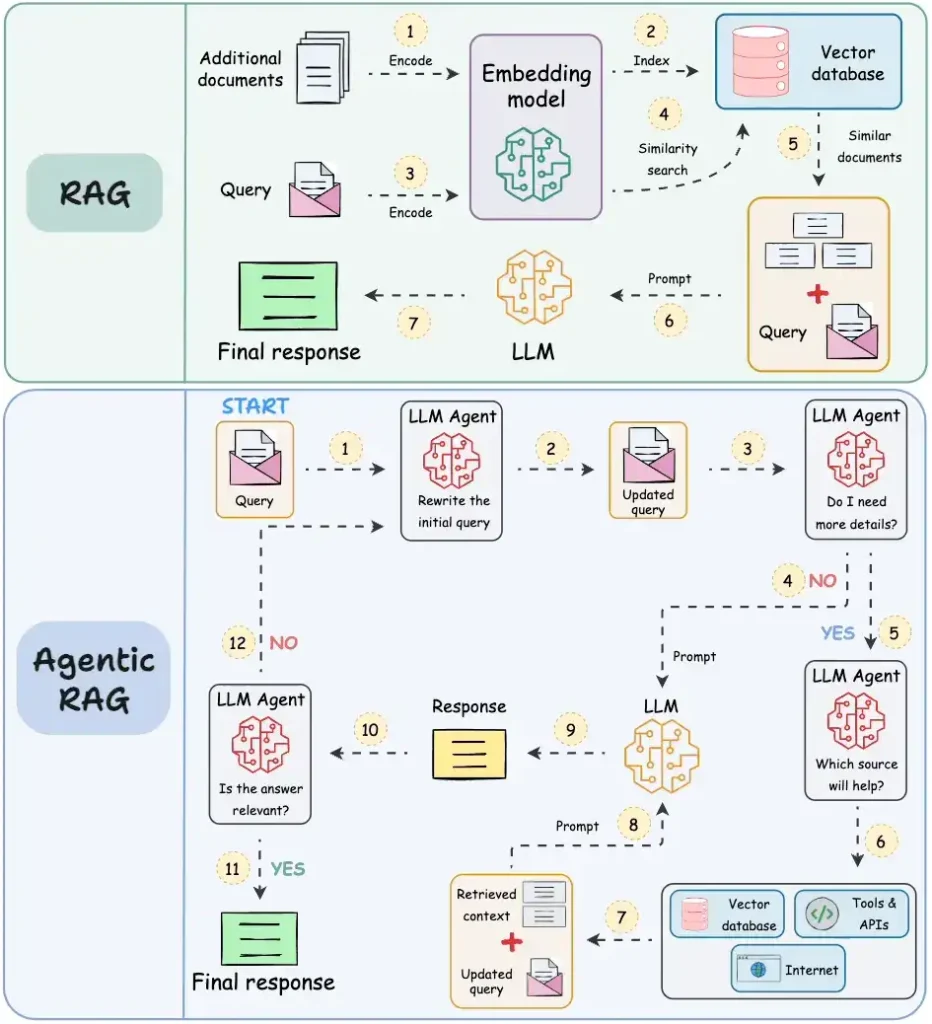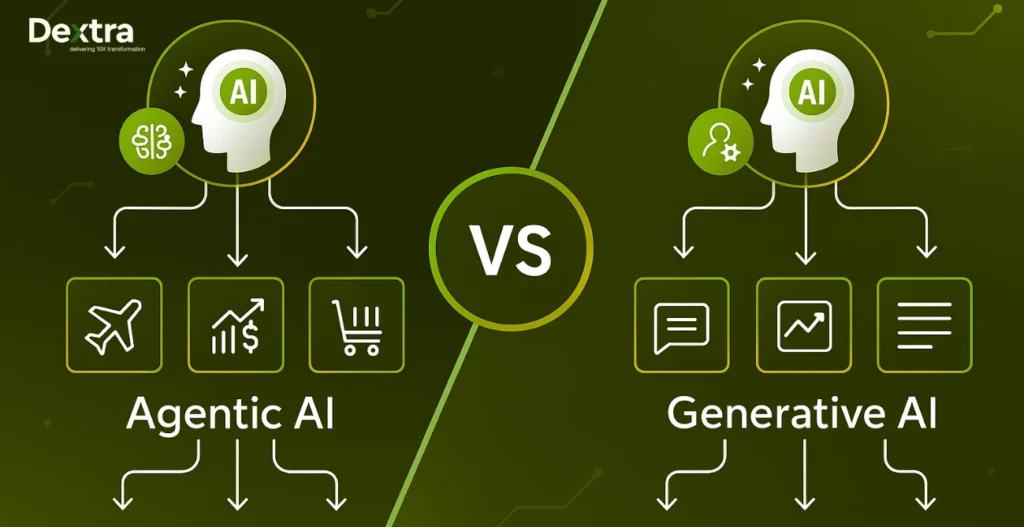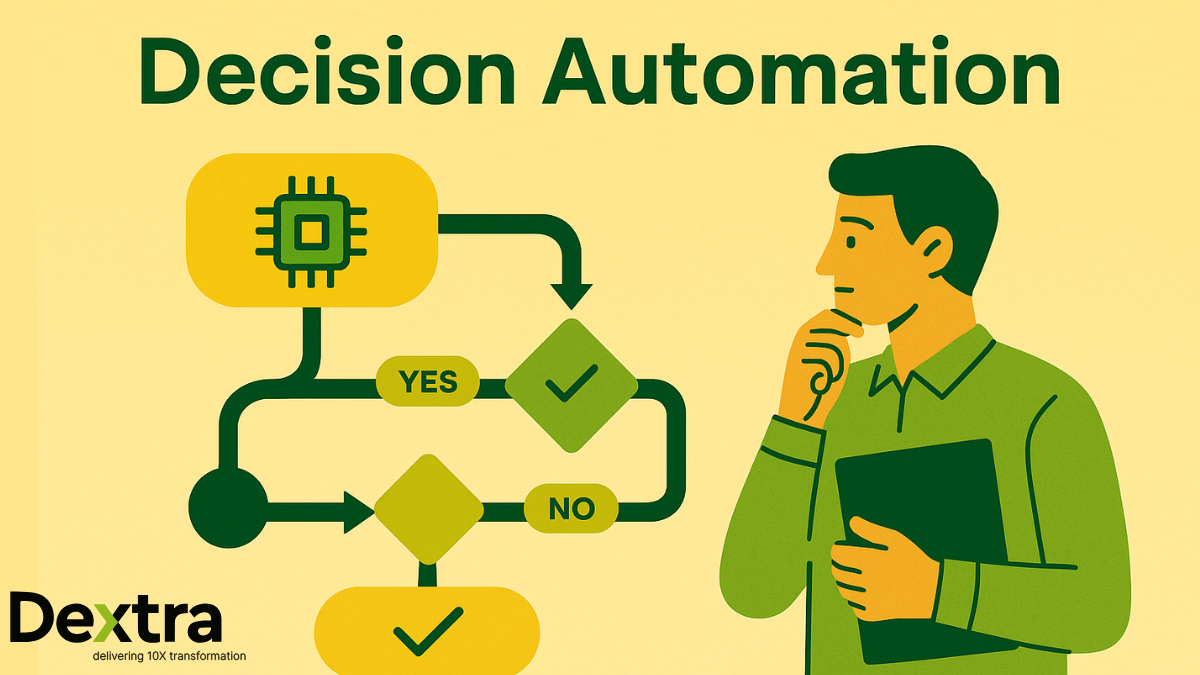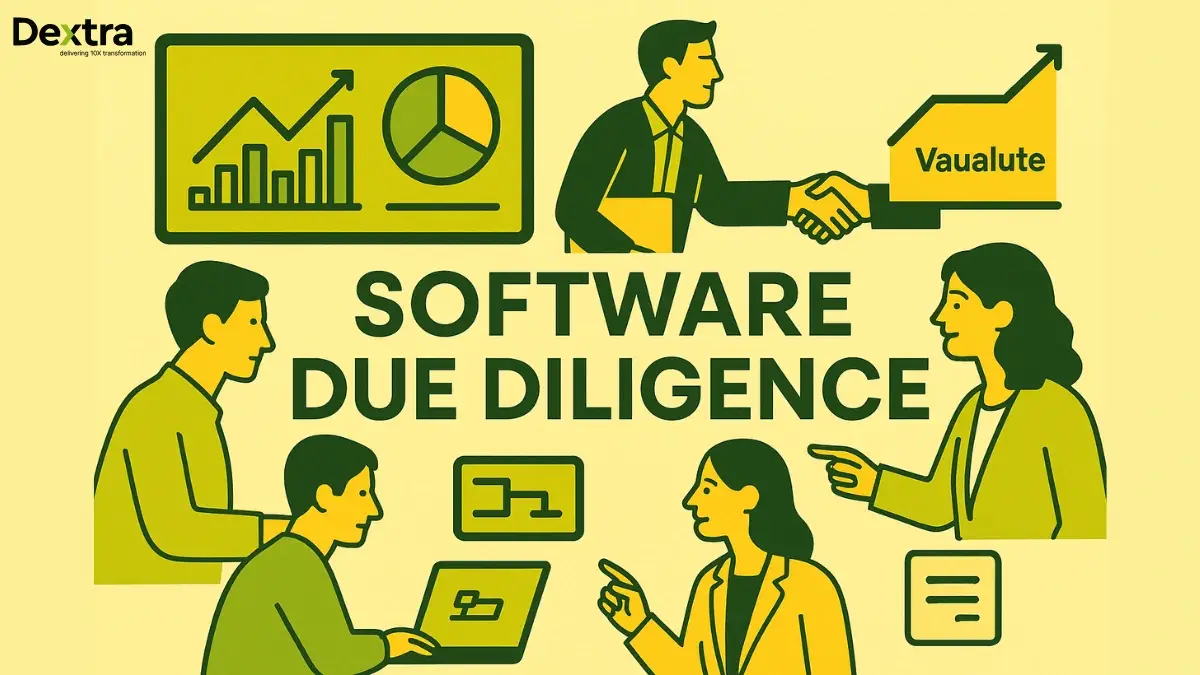As artificial intelligence continues to transform industries worldwide, it’s essential for businesses and organizations to understand the different types of AI driving this change. At Dexterlabs, a Singapore-based AI consultancy, we frequently get questions about two of the most talked-about AI categories today: Agentic AI and Generative AI.
The market data underscore the importance of this distinction. As per Statista, the generative AI market is expected to grow to $62.72 billion by 2025, and the agentic AI market – that is, AI or machine learning that operate without human intervention – is expected to grow to $196.6 billion by 2034 at a stunning 43.8% compound annual growth rate. These figures further emphasize the faster rate of adoption and strategic significance of both generative AI technologies.
So, what exactly is the difference between agentic AI vs generative AI, and why should your organization care? Despite their similarities, the two projects serve somewhat distinct goals in the realms of machine learning and autonomous systems.
Generative AI’s strength is in content generation and creative tasks. Agentic AI’s focus is more on decision-making AI and autonomous operations. This complete guide to agentic AI vs generative AI examples, their different use cases in healthcare, content creation, and more. It also offers the research and guidance you need to better understand the differences and make smart decisions on implementing AI for your organization.
Ready to Integrate Agentic AI?
Let Dextralabs guide your tech transformation with cutting-edge, goal-driven AI solutions tailored for enterprise success.
Book Your Free AI ConsultationWhat is Generative AI?
Generative AI are AI systems that can create original content, such as text, images, audio, or computer code based on input data and patterns learned from prior information. These AI systems are not really all that intelligent, but they are super advanced at discerning complex patterns and then generating human-like responses.
Key Features of Generative AI:
| Features | Description | Business Impact |
| Content Creation Capabilities | Produces original text, images, music, and code | 74% of organizations report meeting or exceeding ROI expectations |
| Pattern Recognition and Replication | Learns from vast datasets to understand and mimic styles | 26% of marketers already using generative AI, 45% planning adoption by 2024 |
| Prompt-Based Interaction | Responds to user inputs and instructions | 71% of organizations regularly use gen AI in at least one business function |
| Creative Output Generation | Produces diverse, creative content variations | 33% of marketers using AI utilize it for generating ideas |
Popular Examples of Generative AI:
- ChatGPT: Advanced conversational AI for text generation
- DALL·E: AI image generator creating artwork from text descriptions
- GitHub Copilot: Code generation assistant for developers
- Midjourney: AI art generator for creative visual content
Primary Use Cases for Generative AI:
Content Marketing: Creation of blog posts, social media content, and marketing copy that follows brand voice and tone.
Design and Art Generation: Making logos, illustrations, and visual content for applications ranging from web design to ad campaigns.
Code Generation: Helping developers develop, debug, and optimize code in multiple programming languages.
What is Agentic AI?
Agentic AI are AI systems broadly defined as capable of making independent decisions and performing autonomous actions to achieve specific desired goals without continuous human involvement. Agentic systems are capable of purposive, goal-directed behavior and revise their plans and/or strategies in response to changes in the environment.
Key Features of Agentic AI:
| Features | Description | Business Impact |
| Autonomy in Operations | Functions independently with minimal human oversight | 33% of enterprise software applications expected to incorporate agentic AI by 2028 |
| Goal-Oriented Behavior | Focused on achieving specific objectives | 40% increase in case resolution rates (Salesforce client data) |
| Decision-Making Capabilities | Makes complex decisions based on data analysis | 92.5% success rate in autonomous data processing and optimization |
| Adaptive Learning | Adjusts strategies based on outcomes and feedback | Projected productivity gains equivalent to adding 187 full-time employees |
Notable Examples of Agentic AI:
- Autonomous vehicles : From fully self-driving cars that can make decisions on the fly to remote-controlled cars.
- Smart Assistants : AI systems that increasingly decide what meetings, travel and other communications we should or should not have.
- Trading Algorithms: Financial systems making investment decisions
- Robotic Process Automation: Systems handling complex business workflows
Primary Use Cases for Agentic AI:
1. Healthcare Diagnostics: AI systems analyze patient data to suggest treatment and pre-emptive health measures completely autonomously.
2. Financial Risk Assessment: Autonomous systems scan loan applications to generate loan or fraud evaluations or decide market-based investment suggestions.
3. Robotics and Automation: Manufacturing robots adapting to production changes and supply chain management systems optimizing logistics operations.
Comparative Analysis: Agentic AI vs Generative AI
It is important to understand the fundamental differences between agentic AI and generative AI in order to select the right technologies for specific use cases.
| Aspect | Generative AI | Agentic AI |
| Primary Function | Content creation and generation | Decision-making and autonomous task execution |
| Interaction Style | Reactive – responds to user prompts | Proactive – initiates actions based on goals |
| Human Involvement | Requires regular prompts and guidance | Operates autonomously once objectives are set |
| Output Type | Creative content (text, images, code) | Actions, decisions, and process execution |
| Learning Approach | Pattern recognition from training data | Reinforcement learning from outcomes |
| Use Case Focus | Creative and content-driven tasks | Operational and strategic decision-making |
| Implementation Complexity | Medium – requires prompt engineering | High – needs goal definition and safety protocols |
| ROI Timeline | Immediate content generation benefits | Long-term operational efficiency gains |
Functional Differences:
- Generative AI: The main function is content creation, producing text, images, code, and other media, based on prompts and trained data.
- Agentic AI: The primary focus is on decision making and task performance, acting independently to execute actions in order to complete pre-defined goals.
Interactivity Patterns:
- Generative AI: Operates reactively, responding to user prompts and instructions to generate requested content
- Agentic AI: Functions proactively, initiating actions and making decisions based on environmental conditions and objectives
Human Involvement Requirements:
- Generative AI: Requires regular user prompts and guidance to produce desired outputs
- Agentic AI: Operates with minimal human input once objectives are established
Integration Potential:
The most powerful AI applications often combine both approaches. For example, an AI customer service system might use agentic capabilities to autonomously handle customer inquiries while employing generative AI to craft personalized, contextually appropriate responses.
Traditional RAG vs Agentic RAG
Traditional RAG (Retrieval-Augmented Generation):
- Combines retrieval systems with generative models.
- Mainly reactive—retrieves and generates based on user queries.
- Example: A chatbot fetching documents and summarizing answers.
Agentic RAG:
- Enhances traditional RAG with agentic capabilities (autonomy, decision logic).
- Can iteratively plan, retrieve, evaluate, and refine responses.
- Acts more like an autonomous agent solving complex tasks (e.g., multi-step reasoning, research).

Why Does It Matters?
- Demonstrates how agentic architecture is redefining traditional generative systems.
- Perfect example of hybrid models evolving in real-world AI systems.
Real-World Applications
Generative AI Applications:
Automated Content Generation: News organizations are using generative AI to produce articles, reports, and summaries, with significantly lower time-to-publish, reaching quality standards.
Personalized Marketing: E-commerce platforms auto-create tailored product descriptions, tailored email campaigns, and tailored social media ads all according to an individual customer’s preferences and behavioural patterns.
Creative Industries: In addition to art, game developers have been utilizing generative AI to create characters, environments and plotlines, as musicians have done when using generative AI to compose melodies and generate lyrics.
Agentic AI Applications:
Autonomous Customer Service Agents: Conversational AI agents that deliver instant, round-the-clock responses to customer questions, handle product returns, set appointments and elevate complicated questions when necessary.
Smart Logistics and Supply Chain Management: Advanced systems that autonomously reorder stock, develop delivery routes or work with manufacturers and suppliers driven by data from demand forecasts to climate forecasts to activity in the marketplace.
Healthcare Management: Autonomous agents that take over monitoring of patient vitals, adjust treatment regimen based on incoming data, and handle the myriad of other complexities involved in coordinating care with several other healthcare professionals.
Ethical Considerations
Generative AI Ethics:
Content Authenticity: The ability to create seemingly authentic fake content poses multiple ethical issues such as misinformation, deep fakes, and loss of trust in the authenticity of digital content.
Possibility of Misinformation: Generated content may promote misinformation inadvertently, and duplicates or expands bias that was present in the training data.
Intellectual property: Issues surrounding rights or copyright surrounding AI-generated content and potential infringement on existing work.
Agentic AI Ethics:
Decision Accountability: Still a difficulty accountable when autonomous AI systems commit errors, such as adverse results from AI (delivering a terrible result when diagnosing an illness).
Bias in Autonomous Decision Making: AI agents can perpetuate or further existing biases using information that they may have captured from the past (ex-bias in hiring, bias in lending, bias from criminal background check).
Privacy and Surveillance: Autonomous AI systems may be collecting and analyzing people’s data autonomously without consent.
Future Outlook
The evolution of both agentic AI and generative AI points toward increasingly sophisticated and integrated systems. Several trends are shaping their future development:
Hybrid AI Models: The combined agentic and generative capabilities will produce new AIs that can autonomously decide and content-generate the right response, for more well-rounded AI systems.
Enhanced Reasoning Capabilities: Unlike today’s AI systems, future AI systems will show better logical reasoning, thus being more dependable when used in applications for high-stakes decisions.
Specialized Industry Applications: Both types of AI will continue to specialize for specific industries with healthcare AI agents, financial generative systems, and educational AI tutors everything from slightly more intelligent to superhuman all in development.
Enhanced Human-AI Collaboration: As opposed to taking over human jobs, these AI tools will start to complement the abilities of human workers, resulting in faster and more effective workflows.
Final Words:
Here’s the bottom line: agentic AI vs generative AI isn’t about choosing sides – it’s about understanding what each does best. Generative AI creates content, agentic AI makes decisions autonomously. The real magic happens when you put both approaches together. With each step of technological advancement, the public and private organizations that best comprehend how to capitalize on each of these types’ individual strengths will have a larger competitive advantage. From content generation to autonomous decision-making, the important thing is finding the right type of AI to fit your needs.
Looking to Transform Your Business with Agentic AI? Partner with Dextralabs to implement autonomous AI systems that drive smarter decisions and scalable outcomes.
FAQs on agentic AI vs generative AI:
Q. What is the difference between generative AI and agentic AI?
Generative AI creates content like text, images, and code based on prompts and training data. It’s reactive and focuses on content generation. Agentic AI makes autonomous decisions and takes independent actions to achieve specific goals. It’s proactive and focuses on decision-making and task execution.
Q. What is the difference between ChatGPT and agentic AI?
ChatGPT is a generative AI model that responds to user prompts by generating conversational text. It requires human input for each interaction. Agentic AI operates autonomously without constant human prompts, making decisions and executing tasks independently to achieve predetermined objectives.
Q. What is the difference between AGI and agentic AI?
AGI (Artificial General Intelligence) refers to AI systems with human-level cognitive abilities across all domains – a theoretical future achievement. Agentic AI refers to current AI systems that can make autonomous decisions within specific domains or tasks, representing a subset of capabilities rather than general intelligence.
Q. What is the difference between agentic AI and reactive AI?
Agentic AI proactively initiates actions based on goals and environmental conditions without waiting for human input. Reactive AI only responds to specific inputs or stimuli, requiring external triggers to function. Agentic systems demonstrate initiative, while reactive systems remain passive until activated.
Q. What is the difference between GenAI and agentic AI?
GenAI (Generative AI) specializes in creating new content such as text, images, music, or code based on learned patterns from training data. Agentic AI focuses on autonomous decision-making and goal achievement. GenAI is creative and content-focused, while agentic AI is action-oriented and decision-focused.
Q. What is an example of a generative AI?
Common examples include:
ChatGPT: Generates conversational text and answers
DALL-E: Creates images from text descriptions
GitHub Copilot: Generates code suggestions and completions
Midjourney: Produces artistic images and designs
Jasper: Creates marketing copy and content
Q. What is generative AI vs normal AI?
Generative AI creates new, original content by learning patterns from training data and generating similar but unique outputs. Normal AI (or traditional AI) typically performs classification, prediction, or analysis tasks without creating new content. Generative AI is creative and produces novel outputs, while traditional AI focuses on processing and analyzing existing data.








